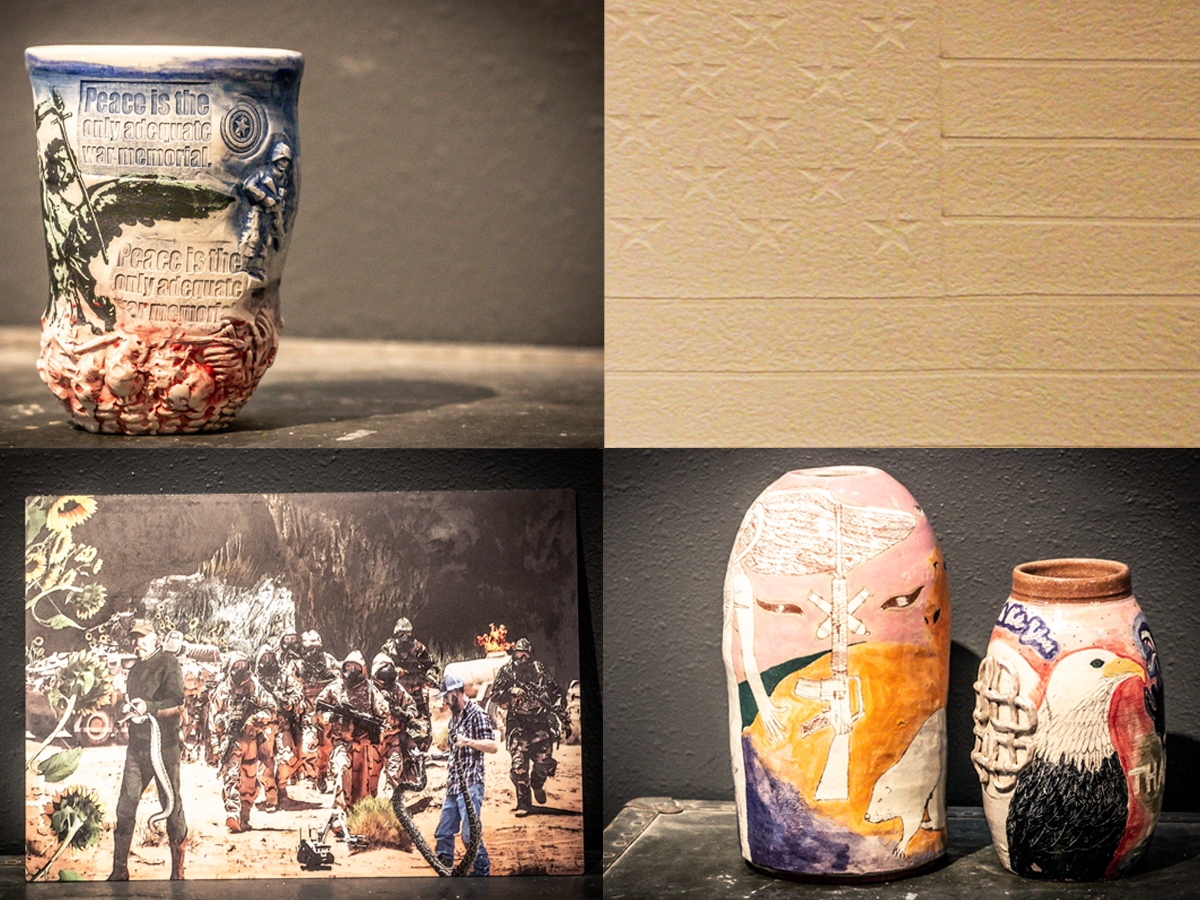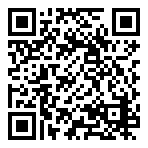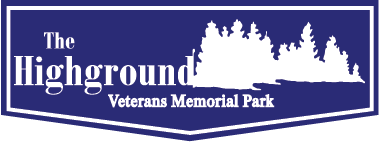
“Exploring PTSD – Healing Through Art” Exhibit
The “Exploring PTSD – Healing Through Art” Exhibit is on display at The Highground Museum July 24-September 26, 2021.
This important exhibition seeks to provide education about PTSD – the history and current thoughts on Post Traumatic Stress Disorder – along with the primary goal of offering ideas and workshops to Veterans and families that may help them with their personal PTSD journeys.
Healing through art has been established as an effective means of allowing a Veteran (or civilian) to express their thoughts and experiences through a creative process, thus encouraging them to be more open to sharing their experiences with fellow Veterans and loved ones. Healing through art also allows the viewer, even civilian viewers, to better see and understand the complex depths of thought and emotion that veterans managing PTSD are experiencing.
Creative arts are almost limitless in their variety and composition. To be able to transfer memories and thoughts to objects made by hand, freeform art, words written in a journal, and an endless number of other expressive activities can start the healing process, allow the person to focus on the creation, and build a sense of direction along with a sense of release and freedom.
Together, The Highground and Veteran Artist Shawn Ganther have created this “Healing Through Art” exhibit as a central part of the “Exploring PTSD” exhibition. It’s an incredible collection of items created by several Veteran artists from across the United States. These items, accompanied by the artist’s biography and vision of how finding art has helped them and others through hard times, invite the viewer to realize the power of what is possible through art.
Veterans and loved ones are also invited to visit a workshop space in The Highground Museum to sample and experience art projects they can work on there or take home.
The “Exploring PTSD” exhibition will also feature interactive space for Veterans and families affected by PTSD to leave written messages – to share their own struggles and to support others who are struggling. It has been said that loneliness can be the greatest struggle of PTSD. For them to see that they are not alone may help them more than we realize.
Part of The Highground’s ongoing mission is to assist Veterans and families managing PTSD. The “Exploring PTSD” exhibition was made possible by sponsors Skip and Debbie Klabon and the generosity of the Veteran artists.
Individuals and businesses that would like to sponsor The Highground’s Veterans programs are encouraged to contact Theresa at 715-743-4224 or by email to museum@thehighground.us. The Highground Museum is open daily from 10am–5pm. The Highground is located at W7031 Ridge Rd, Neillsville WI 54456.
Featured Artists
Shawn Ganther (WI): “First Knight, Unmasked Series” – Shawn is a contemporary painter and printmaker. He served in the United States Air Force from 1998 to 2003 and was involved in Operation Enduring Freedom and Operation Southern Watch. Shawn’s art resume includes shows at the Lincoln Center and Pentagon, collections in the Harvard and Yale Art Library, limited edition Wild Turkey bottle, permanent exhibit at the National Veterans Art Museum, and now a film at the Smithsonian. His work has been published in the 2014 anthology Warrior Writers: A Collection of Writing & Artwork and in Cloth Paper Scissors Magazine.
shawnganther.com
lionheartfilm.com
Ehren Tool (CA): Every Cup Tells a Story – In 1991, Tool was deployed to the Gulf War, first to Saudi Arabia, then to Kuwait. As a field military police officer with First Marine Division as part of Task Force Ripper, he worked as a convoy escort and handler for enemy prisoners of war. “I was super gung ho and a real believer that we were the good guys,” he says. But a few months into his seven-month deployment, he realized it wasn’t that simple. “We were handling one Iraqi soldier, and he said, ‘Baghdad, Baghdad, Baghdad,’ and he put his hand at his shoulder, hand at his hip, hand at his knee. Then, I said out loud, ‘Oh, he has three kids in Baghdad.’” The Marine next to Tool told the man, “Hiroshima, Nagasaki — all gone,” motioning that his family had been killed, even though they didn’t know if it was true. The Iraqi soldier dropped to the ground, sobbing. “It really undermined the idea that we had of the people we were fighting — that they hate freedom, that they’re evil, that they hate us,” says Tool. “This guy was just concerned about his three kids in Baghdad. It really messed with me. I decided I didn’t want to be a gunslinger anymore.”
Today, Tool works as the ceramics studio manager in the Department of Art Practice at UC Berkeley. In his off-time, he creates brutal-looking clay stoneware cups that he decorates with images about war — cups that he hopes will start honest conversations about war and the conflicted, complicated feelings and experiences that come with it. Since Tool began making cups seriously in 2001, he’s made nearly 22,000 — most of which he’s given away or plans to give away. “I don’t believe anything that I do is going to change the world, but nothing in the world is releasing me from my obligation to try.” – Ehren Tool
https://youtu.be/A9Gpr7mjCnE
news.berkeley.edu/2020/02/20/ehren-tool-war-cups
Jay Youngdahl (CA) – “The Complicated Life of a Veteran” piece is a semi-autobiographical collage composed of four separate collages using images from reality and shaped by dreams and memories. Working with materials found in his apartment during the pandemic, such as photos, archived paper documents, and electronic or U.S. Mail, Jay prepared the collage for Veteran’s Day as he served in the U.S. Army as a private during the Vietnam War era.
Sigrid Mabel (NW): “Collage on aluminum” – “On my first deployment, I had Sunday mornings “off”. Wanting to make constructive, positive use of my time, I started collecting magazines sent over in care packages and making collages. I continued making these on my next two mobilizations in much the same fashion — they somehow helped, despite often depicting complicated or dark themes.”
Drew Cameron (IA) – “COMBAT PAPER®” transforms military uniforms into handmade paper. We believe in this simple yet enduring premise that the plant fiber in rags can be transformed into paper. A uniform worn through military service carries with it stories and experiences that are deeply imbued in the woven threads. Creating paper and artwork from these fibers carries these same qualities. We have found that all of us are connected to the military in a myriad of ways. When these connections are discovered and shared it can open a deeper understanding between people and expand our collective beliefs about military service and war.”
combatpaper.org
Jill E. Allen (PA) – Jill Allen is a studio artist working and teaching near Philadelphia, PA. Her sculptural pieces are inspired by the elusive and curious mysteries of “other worlds,” including micro-worlds, the galaxy, the world of science fiction and the human imagination. Originally from a rural town in Wisconsin, Allen grew up exploring the natural details of her surroundings in the country on a daily basis. Paper and steel mills coexisted with natural rivers and farmlands, resulting in both remarkable human inventions and destructive collateral damages. Since then, Allen’s travels across the globe, including a 7-month deployment to Saudi Arabia and Iraq, have expanded her curiosity of the interconnectedness of all living systems. Allen has exhibited her work both nationally and internationally, and holds a BFA from the University of Illinois in Champaign/Urbana, and an MFA from the University of South Carolina in Columbia. Allen was a Supply Specialist in the “other world” of the US Army from 1989-1992, and spent 7 months in the Middle East during Operation Desert Storm/Desert Shield.
http://jillallen.net
theclaystudio.org/artists/jill-allen
Roger Sparks (AK) – Master Sgt. Roger Sparks served as both a Recon Marine and an Air Force Pararescueman for over 25 years. He received a Silver Star, the nation’s third-highest award for valor, for his actions during a fierce firefight with insurgents in Afghanistan’s Watapur Valley on Nov. 14, 2010. His citation reads: “Despite continued enemy fire and with no concern for his personal safety, Sergeant Sparks immediately performed lifesaving measures for nine wounded soldiers.” Roger struggled with post-traumatic stress after that deployment, during which he turned to tattooing. “I couldn’t shake the catharsis of it, like how healing the experience was to be serendipitously tattooed right after that.” Tattooing took on greater meaning as he began tattooing fellow veterans. Sparks is now an artist, author and speaker.
forceblueteam.org/bio/roger-sparks
Aaron Hughes (IL): “War Is Trauma” – Aaron is an artist, curator, organizer, teacher, anti-war activist, and Iraq War veteran. He works collaboratively in diverse spaces and media to create meaning out of personal and collective trauma, deconstruct and transform systems of oppression, and seek liberation. Working through an interdisciplinary practice rooted in drawing and printmaking, Hughes develops projects that deconstruct militarism and related institutions of dehumanization. The “War is Trauma” portfolio transpired out of a street poster project from November 2010, in which a number of Justseeds artists provided graphics for “Operation Recovery” – a campaign to stop the deployment of traumatized troops and win service members and veterans the right to heal. Posters were pasted in public, replacing many corporate advertisements, to focus public attention towards the issues not being discussed – GI Resistance, Post Traumatic Stress Disorder (PTSD), sexual assault in the military or Military Sexual Trauma (MST), and Traumatic Brain Injury (TBI).
justseeds.org/artist/aaronhughes
Jesse Albrecht (MT) – “For me, the hard part starts after combat. Training for and serving in combat was the easy part because the war had my attention. You do all you can to be prepared, but you die, or you don’t. Finding purpose and meaning after the uniform comes off has been challenging. World and life views have been decimated and need to be rebuilt post-combat. The hard part is making meaning, integrating truths and experiences from combat with life after. Reordering, trying to understand how to integrate and relate with those who haven’t been to war, with the searing truths the combat veteran knows, can’t be unknown, can’t be unseen, can’t be unlearned. Nothing makes sense.”
thelineliterary.org/jessealbrecht
thedirtycanteen.wordpress.com/jesse-albrecht
David Giffey (WI): “Long Shadows, The Vietnam Series” – “When another generation of American soldiers was sent to invade a distant nation at the start of the Gulf War in 1991, I began work on the Long Shadow series of paintings. I examined hundreds of photographs I took as a combat journalist with the 1st Infantry Division during the war in Vietnam in 1965-66. Imagery in the paintings refers to some of the photos. For each painting I also chose an excerpt from a journal I kept during the war. I completed the sixth canvas in the Long Shadow series in 2013.” David also designed the “Mourning Dove Effigy Mound” tribute at The Highground as a tribute to POW / MIAs and to those who are struggling with PTSD. While David’s original “Long Shadows” works cannot be at The Highground for this exhibition, a smaller reprinting of the paintings and of David’s photographs from Vietnam that inspired the paintings will be on display in this exhibition.
davidgiffey.com/viet-nam-series.html
Ashley Spangberg (WI) – Patriot Beads & Brass, jewelry and watercolor – “Art has always been a passion of mine. I took every available art class in high school with acrylics and portrait work being my specialties. I even planned on going to Art school when I enlisted in the National Guard, but life took me in a different direction and I spent quite a few years without making art. Dealing with the stress of deployments, being a single mom and going back to school brought me back to art. Nothing heals the heart and mind like a blank canvas, in my opinion at least.”
patriotbeadsandbrass.com/about
Phil Schladweiler (WI) – “The Shrapnel Project” – Excerpt from an article from Love Wisconsin by Scott Schultz (lovewi.com/phil)
“The shrapnel had hit me in a lot of places, and I had many injuries. It hit my eye, right hand, left shoulder and right temple – and the concussion from the artillery rounds going off gave me a mild to moderate traumatic brain injury. I have tinnitus and vertigo and am totally blind in my right eye. My right skull is like a metal mesh kind of thing; my sinus cavities are all screwed up. You know, that good stuff. When I was in the hospital, they actually gave me the shrapnel they pulled out of me. It was put in a little jar like the ones you use when you take drug tests. When I woke up, they told me the story of the shrapnel pieces. It was shocking to see the pieces in the jar. At UW-Eau Claire, I took one of the university’s advanced photography courses and started thinking about how those little pieces of shrapnel had such a huge impact on my life. It’s something small enough that I could hold in my hand that just totally screwed up my entire life. I started photographing the shrapnel and came up with The Shrapnel Project. One of my soldiers committed suicide, so I added one plain, white panel to the exhibit. This blank panel represented post-traumatic stress disorder. It’s a wound, but you can’t really see it. I titled it, “PTSD Wounds Unseen, Unknown”, because it’s different for everybody.”

